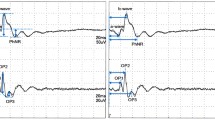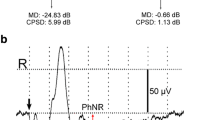Summary
25 patients suffering from retinal detachment are investigated by EOG. (Modification of Arden's technique). The EOG Arden ratio is in the “healthy” fellow eye 186%, that is in the subnormal range. In the diseased eyes the ratio is only 116%. This value improves after operation to 136% but remaines pathological. Patients are devided into the following groups: subjects with successful operation, subjects without successful operation, operation-techniques (scleralresection, diathermy, cerclage), time of check test (50 days p. op., 300 days p.op., 800 days p. op.) age and extension of detachment. Communication of the statistical results. The Arden ratio sinks below zero if operation is unsuccessful, it rises to 175% using the technique cerclage of Arruga. In younger patients with a small area of detachment the results are better than in older ones with a large area. The restitution finishes about 50 days after the operation. While the Arden ratio improves, the actual potential becomes lower after operation.
Zusammenfassung
Es werden elektrooculographische Untersuchungen an 25 Patienten mit Ablatio retinae mitgeteilt. Untersuchungstechnik: Modifikation nach Arden. Der EOG-Arden-Verhältniswert beträgt bei den “gesunden” Partneraugen 186%, liegt folglich jedoch im unteren Normbereich. Bei den erkrankten Augen ist dieser Wert stark erniedrigt (116%). Die Arden ratio bessert sich nach der Operation auf 136%, bleibt also immer pathologisch. Das Patientengut wird in Untergruppen aufgeschlüsselt: Patienten mit erfolgreicher Operation, erfolgloser Operation, Operations-Verfahren (Skleralresektion, Diathermie, Arruga) Zeitpunkt der Kontrolluntersuchung (50 Tage nach der Operation, 300 und 800 Tage nach der Operation), Alter und Ausdehnung der Ablatio. Mitteilung der statistischen Ergebnisse. Der Arden-Verhältniswert geht unter Null bei erfolgloser Operation, bis auf 175% bei der Cerclage nach Arruga. Bei jüngeren Patienten mit kleinerer Ausdehnung der Netzhautablösung sind die Ergebnisse besser als bei älteren und mit großer Ablösung. Die Restitution ist etwa 50 Tage nach der Operation abgeschlossen. Während der Arden-Verhältniswert eine Verbesserung zeigt, nimmt die Gesamtpotentialhöhe in allen Gruppen nach der Operation ab.
Similar content being viewed by others
Literatur
Arden, G. B.: Alteration in the standing potential of the eye associated with retinal disease. Trans. ophthal. Soc. U. K.82, 63–72 (1963).
Asayama R.: Electrorétinographie du décollement, de rétine. J. clin. Ophthal.11, 2, 304 (1957).
Blach, R. K., Behrmann, J.: The electrical activity of the eye in retinal detachment. Trans. ophthal. Soc. U.K.87, 263–266 (1968).
Davis J. R., Shackel, B.: A second survey with electrooculography. Brit. J. Ophthal.44, 337–346 (1960).
——: Changes in the electro-oculogram potential level. Brit. J. Ophthal.44, 606–618 (1960).
Henkes, H. E., Lith, G. H. M. van, Graisiner, P. D., de Haas., J. P.: Electrodiagnostic procedures in diabetes. Iscerg Symp. Ghent p. 393–402. Basel-new York: Karger 1968.
Karpe, G.: The basis of clinical electroretinography. Acta ophthal. (Kbh.) Suppl.24, 1–118 (1945).
Miles, W. R.: Modification of the human eye potential by dark and light adaptation. Science91, 456 (1940).
— Experimental modification of the polarity, potential of the human eye. Yale J. Biol. Med.12, 161–183 (1939).
Mowassaghi, A., Müller-Limmroth, W.: Über den prognostischen Wert einer ERG-Kontrolle bei idiopathischer Netzhautablösung. Fortschr. Med. Nr. 19, 870–873 (1968).
Rendahl, J.: The clinical electroretinogram in detachment of the retina. Acta ophthal. (Kbh.), Suppl.64, 8–83 (1961).
—: The electroretinogram in retinal detachment. Mod. Probl. Ophthal (Basel).5, 127–137 (1967).
—: Das Elektroretinogramm bei Ablatio retinae. Elektroretinographie, Symposion in Hamburg 1956. Bibl. opthal. (Basel)48, 190–195 (1957).
Schmidt, B.: Die Elektrooculographie als klinische Untersuchungsmethode. Klin. Mbl. Augenheilk.151, 249–258 (1967).
Schmöger, E.: Die prognostische Bedeutung des Elektroretinogramms bei Ablatio retinae. Klin. Mbl. Augenheilk.131, 335–343 (1957).
—: Das Elektroretinogramm vor und nach erfolgreicher Operation der Netzhautablösung. Albrecht v. Graefes Arch. Ophthal.166, 211–219 (1963).
Stagni, S., Tuvo, F., Rinaldi, G.: Contributo alla conoscenza dell tracciato ERG in distacchi de retina, prima e dopo intervento, eseguito con diverse techniche (Beitrag zur Kenntnis der ERG-Kurve bei Netzhautablösung vor und nach der Operation). Atti 47. Congr. Soc. oftal. ital.21, 29–44 (1964). Z. Augenheilk.96, 309 (1966).
Straub, W.: Das Elektroretinogramm. Bücherei des Augenarztes, H. 36. Stuttgart: Enke 1960.
Wirth, A.: Alcune osservazioni cliniche di electroretinografia. Atti Soc. ottal. ital.12, 199 (1951).
Author information
Authors and Affiliations
Rights and permissions
About this article
Cite this article
Schmidt, B. Elektrooculographische Untersuchungen bei Ablatio retinae. Albrecht von Graefes Arch. Klin. Ophthalmol. 180, 20–30 (1970). https://doi.org/10.1007/BF02384818
Received:
Issue Date:
DOI: https://doi.org/10.1007/BF02384818




